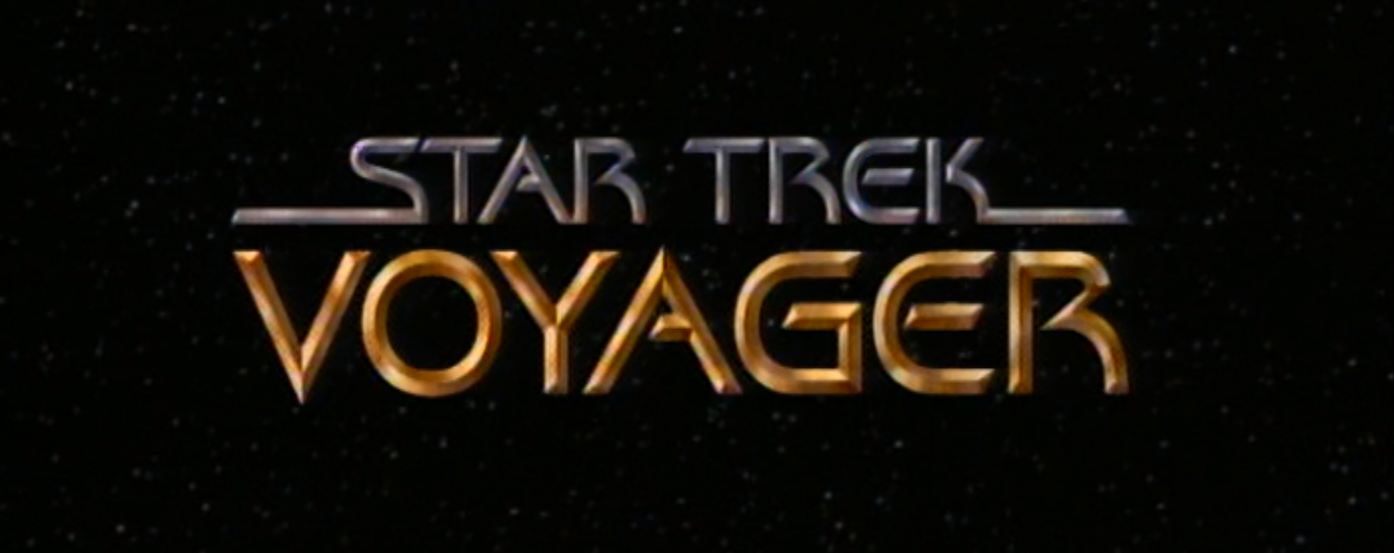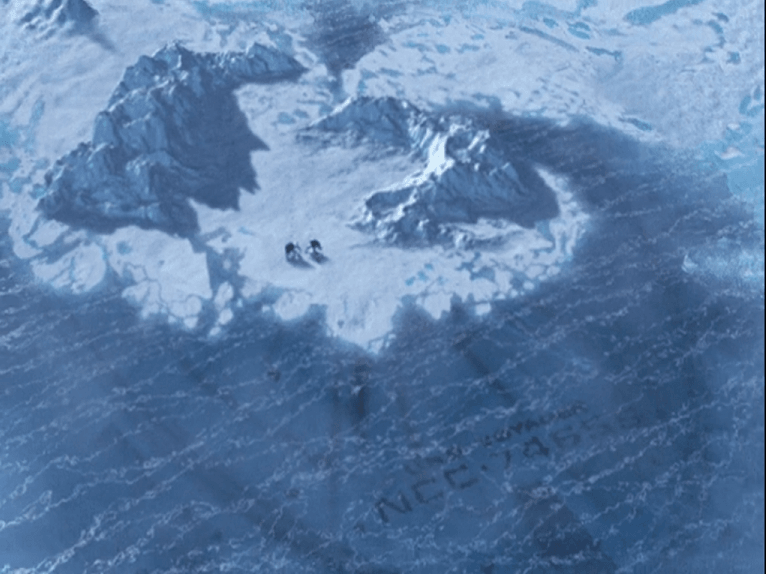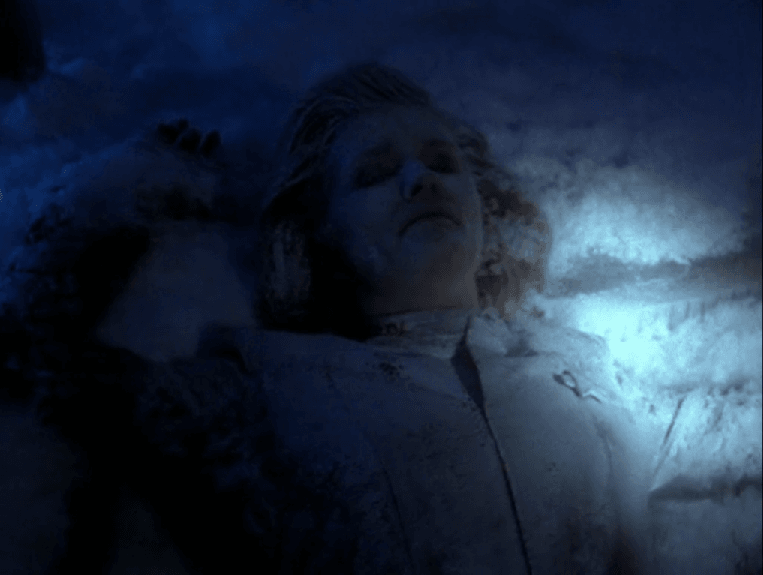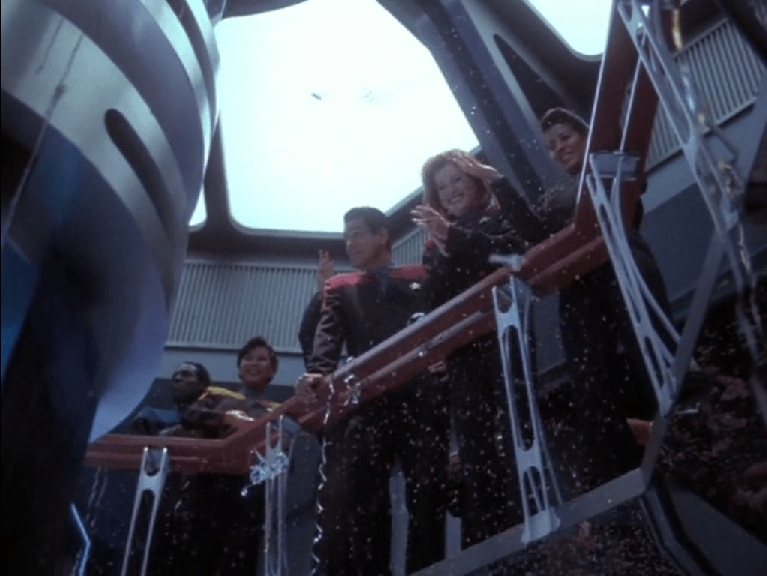
Welcome back to ‘Final Frontier Friday’! Last time around, I made a lot of hay about not wanting to be “late to the party” for the fiftieth anniversary of ‘Plato’s Stepchildren‘ (which we hit on Thanksgiving). But in making sure I was on time (a little early, actually) for that party, I missed another one: the twentieth anniversary of the ‘Voyager’ episode ‘Timeless’. Deciding which episode to cover was a tough call but… well, okay, it wasn’t. Not really. I had to go with the bigger anniversary, and that was obviously ‘Plato’s Stepchildren’. But still, I didn’t want to let ‘Timeless pass unremarked upon, and conveniently I had another column to write a mere two weeks later. How convenient! So here we are, for the one-hundredth episode of ‘Star Trek: Voyager‘.
 It’s funny. Most shows make a big deal about their centennial episode because, well, it is a pretty significant milestone. If nothing else, it usually means that the show has reached its fifth season (itself no mean feat) and one hundred episodes has traditionally been considered the “magic number” for a show to be sold into syndication, and thus achieve immortality in reruns. And live action ‘Trek’ has hit that number more than once, with ‘The Next Generation’, ‘Deep Space Nine’, and ‘Voyager’ all crossing that threshold. But I want you to stop and think for a moment. Without Googling it, can you name the hundredth episodes of ‘The Next Generation’ or ‘Deep Space Nine’? It’s ‘Redemption’ and ‘Nor the Battle to the Strong’, respectively. Good episodes, to be sure, but they didn’t exactly make a fuss about it, even in the episode promos (check YouTube if you don’t believe me). ‘Voyager’, by contrast? There was a fuss. Not only was ‘Timeless’ actually promoted as the hundredth episode, but it was conceived with that fact in mind.
It’s funny. Most shows make a big deal about their centennial episode because, well, it is a pretty significant milestone. If nothing else, it usually means that the show has reached its fifth season (itself no mean feat) and one hundred episodes has traditionally been considered the “magic number” for a show to be sold into syndication, and thus achieve immortality in reruns. And live action ‘Trek’ has hit that number more than once, with ‘The Next Generation’, ‘Deep Space Nine’, and ‘Voyager’ all crossing that threshold. But I want you to stop and think for a moment. Without Googling it, can you name the hundredth episodes of ‘The Next Generation’ or ‘Deep Space Nine’? It’s ‘Redemption’ and ‘Nor the Battle to the Strong’, respectively. Good episodes, to be sure, but they didn’t exactly make a fuss about it, even in the episode promos (check YouTube if you don’t believe me). ‘Voyager’, by contrast? There was a fuss. Not only was ‘Timeless’ actually promoted as the hundredth episode, but it was conceived with that fact in mind.
The episode itself originated with Brannon Braga, who had taken over as showrunner upon the retirement of Jeri Taylor earlier that year. As related by then-staff writer Bryan Fuller, the central image that gave rise to the episode was that of Voyager crashing into the ice. Braga and co-writer Joe Menosky also made a point of avoiding the usual cliches of time travel episodes, ending up with what Menosky describes as a “post-modern time travel story,” so called because none of the characters actually travel through time, just the proverbial message in a bottle. In a similarly unorthodox move, the decision was made to center the landmark episode on Harry Kim. This was an extension of more general efforts the ‘Voyager’ writers were making at the time to spotlight some of the show’s lesser used characters. But why Kim specifically? Well, according to Menosky. the choice was at least partially inspired by Garret Wang’s performance in the ‘Killing Game’ two-parter late in the fourth season. Now to see whether all these chances they took paid off…
 The episode opens on a frozen wasteland, as two figures beam in. They progress silently until they reach their destination, at which time the camera pulls back to reveal Voyager, entombed in the glacier.
The episode opens on a frozen wasteland, as two figures beam in. They progress silently until they reach their destination, at which time the camera pulls back to reveal Voyager, entombed in the glacier.
The two – now revealed to be Chakotay and Kim – beam aboard the frozen Voyager. Once aboard, they split up. Chakotay heads for the bridge, where searches the bodies of his former crewmates, eventually coming across Seven of Nine’s body, which he has beamed aboard their ship. Kim, meanwhile, arrives in sickbay, where he manages to reactivate the Doctor, who is horrified to see what’s become of the ship. He demands an explanation, which he receives as Chakotay enters the room. They’re here, he tells the hologram, to change history.
Fifteen years earlier, the crew of Voyager is celebrating in the engine room, where they’re christening the ship’s new quantum slipstream drive. The new engine is expected to go online the next day, and if it works as planned, the trip home will take hours instead of decades. As the Doctor escorts a tipsy Seven to sickbay, Paris tells Kim that he’s worried the slipstream drive might be a disaster in the making, pointing to a seemingly small phase variance that could knock bring their flight to a catastrophic end. Kim writes these concerns off to a sensor glitch but nonetheless agrees to run a fresh round of simulations in the holodeck. The simulated flight is less than successful, with the phase variance forcing the holographic Voyager out of the slipstream and to its doom twenty-three times over. Kim has a plan, though. By taking a shuttle ahead of Voyager, he could relay phase corrections back to Voyager, making for a smoother ride. Though Tuvok and Janeway, in particular, are reticent, Kim points out that the crystals that power the drive are already decaying, and that it could take years to synthesize replacements. Janeway has him draw up a flight plan, which she decides to follow through on after some consideration.
 Back in the future, Kim and Chakotay bring the Doctor up to speed aboard the Delta Flyer. They’re orbiting a planet in the Takara sector, just outside the Alpha Quadrant. Fifteen years ago, Voyager went ahead with the slipstream flight. It did not go well, and Kim, Chakotay, and now the Doctor are all that remains of the crew. Kim bitterly notes that the two of them made it home, and all it cost was the lives of everyone they cared about. Starfleet gave up looking for Voyager’s crash site six years after their return, and the two continued the search on their own. They then reveal to the Doctor exactly what they’re doing here. As Chakotay said, they hope to alter history, preventing the crash from ever happening. No less bitterly, Kim tells the Doctor that Voyager’s destruction was his fault. He and Chakotay took the Flyer ahead of Voyager as planned, sending corrections back to the ship. But Kim screwed up. His corrections only increased the phase variance, causing the disaster he was trying to prevent. The Doctor dryly wonders if it isn’t a bit late to send the corrected corrections to Voyager. What they plan to do is send a message back through time, using a piece of Borg tech they “borrowed” from Starfleet and a pair of implants that they need the Doctor to remove from Seven’s cadaver. Their compatriot, Tessa, joins them in the lab. A Starfleet ship is nearby, so she’s brought the ship into a lower orbit to prevent (or delay)their being noticed. Kim exposits some more, explaining to the Doctor that they’re all wanted criminals. In addition to the Borg temporal transmitter, they stole the Delta Flyer and the charges they face include treason and conspiracy to violate the Temporal Prime Directive. As the Doctor gets to work, Chakotay and Tessa beam back down to retrieve Voyager’s sensor logs. While Chakotay and Tessa go about their business, the Flyer’s computer sounds the alert: Starfleet is on its way. It’s now or never.
Back in the future, Kim and Chakotay bring the Doctor up to speed aboard the Delta Flyer. They’re orbiting a planet in the Takara sector, just outside the Alpha Quadrant. Fifteen years ago, Voyager went ahead with the slipstream flight. It did not go well, and Kim, Chakotay, and now the Doctor are all that remains of the crew. Kim bitterly notes that the two of them made it home, and all it cost was the lives of everyone they cared about. Starfleet gave up looking for Voyager’s crash site six years after their return, and the two continued the search on their own. They then reveal to the Doctor exactly what they’re doing here. As Chakotay said, they hope to alter history, preventing the crash from ever happening. No less bitterly, Kim tells the Doctor that Voyager’s destruction was his fault. He and Chakotay took the Flyer ahead of Voyager as planned, sending corrections back to the ship. But Kim screwed up. His corrections only increased the phase variance, causing the disaster he was trying to prevent. The Doctor dryly wonders if it isn’t a bit late to send the corrected corrections to Voyager. What they plan to do is send a message back through time, using a piece of Borg tech they “borrowed” from Starfleet and a pair of implants that they need the Doctor to remove from Seven’s cadaver. Their compatriot, Tessa, joins them in the lab. A Starfleet ship is nearby, so she’s brought the ship into a lower orbit to prevent (or delay)their being noticed. Kim exposits some more, explaining to the Doctor that they’re all wanted criminals. In addition to the Borg temporal transmitter, they stole the Delta Flyer and the charges they face include treason and conspiracy to violate the Temporal Prime Directive. As the Doctor gets to work, Chakotay and Tessa beam back down to retrieve Voyager’s sensor logs. While Chakotay and Tessa go about their business, the Flyer’s computer sounds the alert: Starfleet is on its way. It’s now or never.
